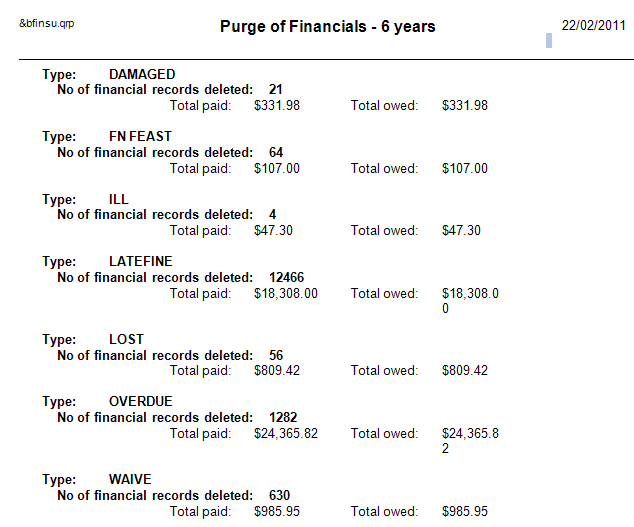Delete Borrower - Single entry financials in 5.3 and 5.4
This report allows the deletion of paid Borrower Financial Transactions. Care should be taken when deleting Financial records as once the entry has been deleted it cannot be retrieved.
It should be noted that only Financials will be deleted if the Borrower:
- Has transactions which are paid and balanced
- Owes $0.00
- Are more than those required to keep as set in Supervisor>Installation>Circulation > Keep the last ### history (this applies to History transactions to be left in the Borrower Financial)
Financial Reports
Update Report Templates
The following report templates can be used in the Reports module to delete Financials if Update Entity is set to Y, and the report is run via the report Scheduler. The F7 Where statement is used to determine which records will be deleted.
Templates
- &BORFINP.QRP – Deletes Borrower Financial Transactions records and creates a list of EVERY Borrower and Transaction . Send to File for record purposes??
- &BFINSU.QRP – Deletes Borrower Financial Transactions records & produces a count of the records deleted (based on &BORFINP.QRP)
Financial Reports for Borrower (&borfinp.qrp)
This report will perform differently depending on the Supervisor parameter (Supervisor/LibraryMenu/Installation/System/Use Double Line Accounting). These instructions are for Single line accounting (Use Double Line Accounting = N).

Note: Ensure the Template is a Purge Financial Report Type
Because the Report is large, you may like to send it to a File rather than Paper.
Create Financial Deletion Report
Step 1: Creating a Full Report to File for Checking
- Go to Main > Reports > RepBorrower.
- Click the F1 New button – the Select Report Format screen will appear
- Highlight the Borrower Financial report template you would like to use – &BORFINP.QRP (Borrower financial Summary). You should locate these templates via Template name rather than Description, as these are multi-function templates and sometimes the Description refers to this alternate functionality. If it does not exist it can be created in Reports > RepAddNew or contact Amlib Support if unsure.
- Click the OK button.
- Type in a Description – for example: Delete Financials more than 6 Years Old
- Ensure the Update Entity (Y/N) column is set to N
- Click the F3 Save button.
- Select the F7 Where button to set up the selection parameters – this will bring up the Borrower Reports – Where screen
- Enter the following Where search:
- Enter a start date: FinTrans Date <= enter a date in DD/MM/YYYY format – for example: 01/01/2005 or use the Special Button. Select Current Date and enter 72 in the Months Box (for 6 years).
- It is possible to use other Where conditions e.g. for Financial Types, or Borrower Types etc. if you want only specific Financials deleted.
- Click the F3 Save button when complete.
- Click the F9 Order button – this will bring up the Borrower Reports – Order By screen.
- Select BorBarcode from the Columns list and arrow it across into the Order By list.
- Click the F3 Save button when complete.
- Print F6 Print. It is suggested File is chosen to send the Report to an rtf File.

- Click OK.
- Enter the File name and Browse to the Destination Location.
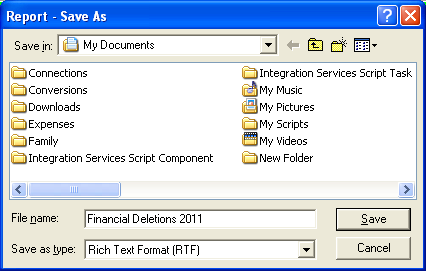
Schedule Report
Start the Scheduler
- From the Reports screen, select Application > RepStartSchedule.

- The Report Scheduler screen will then open.
- Select your printing options: Ensure Save to File is ticked (you can tick all three if you intend on printing up multiple reports using multiple formats during a session).
- Also decide If a report is scheduled by another user do you still want to print it? = Yes/No

- Then click the OK button.
- After clicking OK, if you go back into the Application menu you will see that RepStartSchedule is now greyed out with a tick next to it – this indicates that the Scheduler is now running

Note: If you need to restart the scheduler at any point, you will need to log out of all Report screens (Ctrl + L) and start at the beginning of these instructions.
Check Print Progress
- You can check the progress of your reports at any time by going into Main > Reports > RepPrintProgress.
- If your library uses the scheduler for a lot of reports, you can select a frequency type from the Filter drop-down menu at the top:
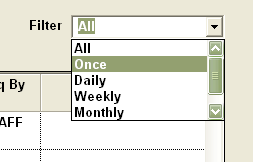
- You can also click through the three tab options at the top to see the ones that are Waiting, Running, or have already been Printed.

- Your report will show up in “Printed” when it is complete
Example of Listing (&borfinp.qrp)
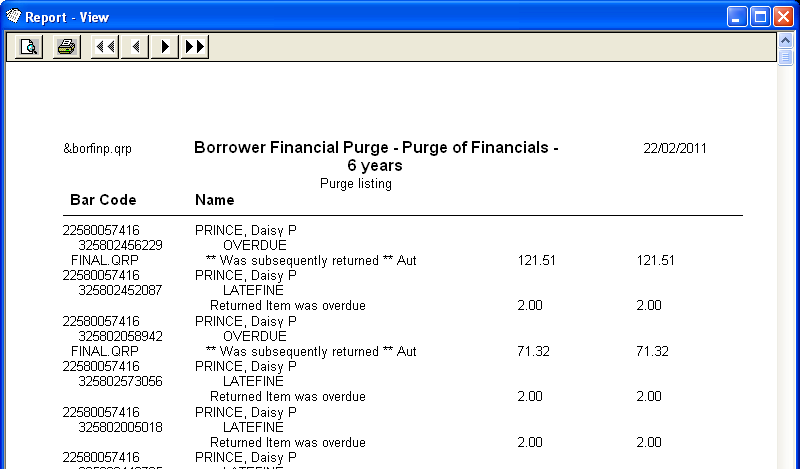
Step 2: Creating the Summary and Clearing the Financials
- Go to Main > Reports > RepBorrower.
- Highlight the Report that was run earlier to get the listing.
- Click the F2 Modify button – the Select Report Format screen will appear.
- Highlight the Borrower Summary Financial report template– &BORFINSU.QRP (Borrower financial Summary). If it does not exist it can be created in Reports > RepAddNew or contact Amlib Support if unsure.
- Click the OK button.
- Ensure the Update Entity (Y/N) column is set to Y
- Click the F3 Save button.
- Print F6 Print. It is suggested File is chosen to send the Report to an rtf File.

- Click OK.
- Enter the Summary File name and Browse to the Destination Location.
Schedule Report
Start the Scheduler
- From the Reports screen, select Application > RepStartSchedule.

- The Report Scheduler screen will then open.
- Select your printing options: Ensure Save to File is ticked (you can tick all three if you intend on printing up multiple reports using multiple formats during a session).
- Also decide If a report is scheduled by another user do you still want to print it? = Yes/No
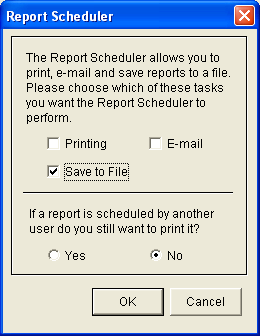
- Then click the OK button.
- After clicking OK, if you go back into the Application menu you will see that RepStartSchedule is now greyed out with a tick next to it – this indicates that the Scheduler is now running.

Note: If you need to restart the scheduler at any point, you will need to log out of all Report screens (Ctrl + L) and start at the beginning of these instructions.
Check Print Progress
- You can check the progress of your reports at any time by going into Main > Reports > RepPrintProgress.
- If your library uses the scheduler for a lot of reports, you can select a frequency type from the Filter drop-down menu at the top:
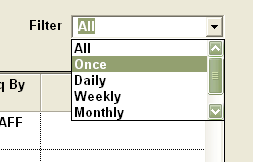
- You can also click through the three tab options at the top to see the ones that are Waiting, Running, or have already been Printed.

- Your report will show up in “Printed” when it is complete
Example of Summary (&borfinsu.qrp)
